| Name | Year | Formation | Location | Notes | Images |
|---|
| Abditosaurus | 2022 | Tremp Formation (Late Cretaceous, Maastrichtian) |  Spain Spain | Larger and distantly related to other European sauropods, suggesting it was an immigrant from another continent [1] |  |
| Acanthopholis | 1867 | Chalk Group (Late Cretaceous, Cenomanian) |  United Kingdom United Kingdom
( England) England) | Possessed keeled oval scutes as well as long spines |  |
| Adynomosaurus | 2019 | Tremp Formation (Late Cretaceous, Maastrichtian) |  Spain Spain | Relatively basal despite its late age [2] |  |
| Aepisaurus | 1852 | Grès verts hevétiques (Early Cretaceous, Albian) |  France France | Known only from a humerus which shares some features with camarasaurids and titanosaurs [3] |  |
| Ajkaceratops | 2010 | Csehbánya Formation (Late Cretaceous, Santonian) |  Hungary Hungary | Known for its sharply hooked upper beak |  |
| Allosaurus | 1877 | Lourinhã Formation (Late Jurassic, Kimmeridgian) |  Portugal Portugal | Three species, including the type, are known from the United States. The European species may be a synonym of A. fragilis, [4] [5] [6] but at least one study suggests that it is indeed valid [7] |  |
| Alocodon | 1973 | Cabaços Formation (Late Jurassic, Oxfordian) |  Portugal Portugal | Had vertical grooves on its teeth |  |
| Altispinax | 1923 | Wadhurst Clay Formation (Early Cretaceous, Valanginian) |  United Kingdom United Kingdom
( England) England) | Possessed elongated neural spines that may have supported a hump-like structure as in Concavenator |  |
| Amanzia | 2020 | Reuchenette Formation (Late Jurassic, Kimmeridgian) |  Switzerland Switzerland | One bone preserves fossilized cartilage. [8] Originally believed to be a species of Ornithopsis or Cetiosauriscus |  |
| Ampelosaurus | 1995 | Argiles et Grès à Reptiles Formation, Grès de Labarre, Gres de Saint-Chinian, Marnes Rouges Inférieures Formation (Late Cretaceous, Maastrichtian) |  France France | Had three different types of osteoderms, including spines, plates and bulbs |  |
| Anoplosaurus | 1879 | Cambridge Greensand (Early Cretaceous, Albian) |  United Kingdom United Kingdom
( England) England) | Considered an ankylosaur despite the fact no osteoderms have been found. Historically suggested to be an ornithopod | 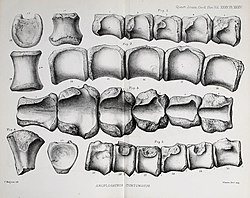 |
| Aragosaurus | 1987 | Villar del Arzobispo Formation (Early Cretaceous, Berriasian) |  Spain Spain | Reportedly had a unique ischium |  |
| Arcovenator | 2014 | Argiles et Grès à Reptiles Formation (Late Cretaceous, Campanian) |  France France | Most closely related to abelisaurids from India and Madagascar [9] |  |
| Arenysaurus | 2009 | Tremp Formation (Late Cretaceous, Maastrichtian) |  Spain Spain | One of the last lambeosaurines prior to their extinction |  |
| Aristosuchus | 1887 | Wealden Group (Early Cretaceous, Barremian) |  United Kingdom United Kingdom
( England) England) | May have had long claws based on referred unguals |  |
| Asylosaurus | 2007 | Avon Fissure Fill (Late Triassic, Rhaetian) |  United Kingdom United Kingdom
( England) England) | Remains originally identified as Thecodontosaurus |  |
| Atsinganosaurus | 2010 | Argiles et Grès à Reptiles Formation (Late Cretaceous, Maastrichtian) |  France France | Belongs to a unique clade of southwestern European titanosaurs [10] | 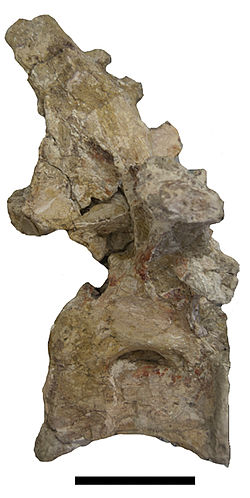 |
| Aviatyrannis | 2003 | Alcobaça Formation (Late Jurassic, Oxfordian to Tithonian) |  Portugal Portugal | Although originally described as a tyrannosauroid, it may in fact be the oldest known ornithomimosaur [11] | 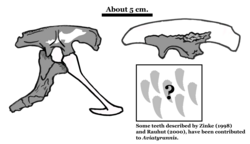 |
| Barilium | 2010 | Wadhurst Clay Formation (Early Cretaceous, Valanginian) |  United Kingdom United Kingdom
( England) England) | Robust with strong vertebrae and short neural spines |  |
| Baryonyx | 1986 | Weald Clay (Early Cretaceous, Barremian) |  United Kingdom United Kingdom
( England) England) | One specimen was found with the remains of fish and a juvenile iguanodont in its stomach, suggesting it was a generalist predator [12] |  |
| Betasuchus | 1932 | Maastricht Formation (Late Cretaceous, Maastrichtian) |  Netherlands Netherlands | The first terrestrial vertebrate named from the Maastrichtian stage [13] |  |
| Blasisaurus | 2010 | Arén Formation (Late Cretaceous, Maastrichtian) |  Spain Spain | Only known from a partial skull but can be distinguished from contemporary lambeosaurines [14] |  |
| Bothriospondylus | 1875 | Kimmeridge Clay (Late Jurassic, Kimmeridgian) |  United Kingdom United Kingdom
( England) England) | Several specimens have been assigned to this genus, but most of them have been reclassified into different genera |  |
| Bradycneme | 1975 | Sânpetru Formation (Late Cretaceous, Maastrichtian) |  Romania Romania | Potentially an alvarezsaurid [8] |  |
| Brighstoneus | 2021 | Wessex Formation (Early Cretaceous, Barremian) |  United Kingdom United Kingdom
( England) England) | Possessed a long snout tipped with a low bump |  |
| Burianosaurus | 2017 | Peruc-Korycany Formation (Late Cretaceous, Cenomanian) |  Czech Republic Czech Republic | May be closely allied to the rhabdodontids [15] |  |
| Calamosaurus | 1891 | Wessex Formation (Early Cretaceous, Barremian) |  United Kingdom United Kingdom
( England) England) | Only known from two cervical vertebrae. Several bones have been referred to it over the years but there is no way to prove all of them belonged to the same genus | 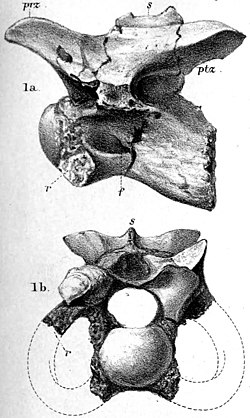 |
| Calamospondylus | 1866 | Wessex Formation (Early Cretaceous, Hauterivian) |  United Kingdom United Kingdom
( England) England) | Only definitively known from a sacrum and associated pelvic elements |  |
| Caletodraco | 2024 | Chalk of the Pays de Caux (Late Cretaceous, Cenomanian) |  France France | Possibly the first known non-South American furileusaurian abelisaurid [16] |  |
| Callovosaurus | 1980 | Oxford Clay (Middle Jurassic, Callovian) |  United Kingdom United Kingdom
( England) England) | The oldest known dryosaurid [17] |  |
| Calvarius | 2023 | Tremp Formation (Late Cretaceous, Maastrichtian) |  Spain Spain | May have been a cursorial biped similar to basal ornithopods despite being more derived |  |
| Camarillasaurus | 2014 | Camarillas Formation (Early Cretaceous, Barremian) |  Spain Spain | Described as a ceratosaur [18] but has since been reinterpreted as a spinosaurid [19] [20] |  |
| Camelotia | 1985 | Westbury Formation (Late Triassic to Early Jurassic, Rhaetian to Hettangian) |  United Kingdom United Kingdom
( England) England) | One of the largest known non-sauropod sauropodomorphs |  |
| Canardia | 2013 | Marnes d'Auzas Formation (Late Cretaceous, Maastrichtian) |  France France | May have been a close relative of Aralosaurus |  |
| Cardiodon | 1841 | Forest Marble Formation (Middle Jurassic, Bathonian) |  United Kingdom United Kingdom
( England) England) | The first sauropod ever named. [21] Known only from a tooth | 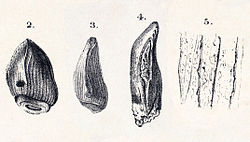 |
| Cariocecus | 2025 | Papo Seco Formation (Early Cretaceous, Barremian) |  Portugal Portugal | Represents the first Portuguese iguanodontian skull [22] |  |
| Ceratosuchops | 2021 | Wessex Formation (Early Cretaceous, Barremian) |  United Kingdom United Kingdom
( England) England) | Differs from Baryonyx in subtle details of its skull |  |
| Cetiosauriscus | 1927 | Oxford Clay (Middle Jurassic, Callovian) |  United Kingdom United Kingdom
( England) England) | Has been assigned to a variety of positions around Eusauropoda [23] [24] [25] | 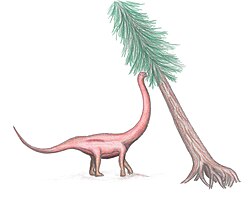 |
| Cetiosaurus | 1841 | Rutland Formation (Middle Jurassic, Bajocian to Bathonian) |  United Kingdom United Kingdom
( England) England) | The first sauropod known from decent remains. Once believed to be a large seagoing animal | 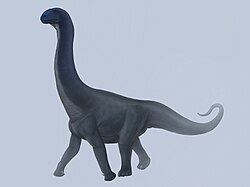 |
| Chondrosteosaurus | 1876 | Wessex Formation (Early Cretaceous, Barremian) |  United Kingdom United Kingdom
( England) England) | The air sacs in its vertebrae were originally believed to be filled with cartilage | 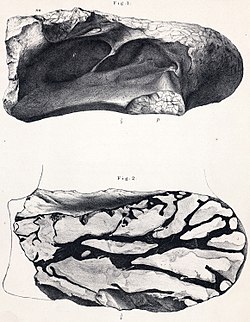 |
| Compsognathus | 1859 | Alcobaça Formation?, Canjuers Lagerstätte, Solnhofen Limestone (Late Jurassic, Tithonian) |  France France
 Germany Germany
 Portugal? Portugal? | One of the smallest known non-avian dinosaurs |  |
| Comptonatus | 2024 | Wessex Formation (Early Cretaceous, Barremian to Aptian) |  United Kingdom United Kingdom
( England) England) | One of the most completely known ornithopod taxa from the Isle of Wight |  |
| Concavenator | 2010 | La Huérguina Formation (Early Cretaceous, Barremian) |  Spain Spain | Preserves bumps on its ulna which have been interpreted as quill knobs, [26] although they might have been muscle attachments instead [27] |  |
| Craspedodon | 1883 | Lonzée Member (Late Cretaceous, Santonian) |  Belgium Belgium | May be the first neoceratopsian known from Europe [28] | 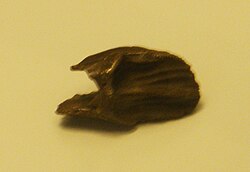 |
| Craterosaurus | 1874 | Woburn Sands Formation (Early Cretaceous, Aptian to Albian) |  United Kingdom United Kingdom
( England) England) | Potentially synonymous with Regnosaurus |  |
| Cruxicheiros | 2010 | Chipping Norton Limestone (Middle Jurassic, Bathonian) |  United Kingdom United Kingdom
( England) England) | Inconsistent in phylogenetic placement |  |
| Cryptosaurus | 1869 | Ampthill Clay (Late Jurassic, Oxfordian) |  United Kingdom United Kingdom
( England) England) | Only known from a single femur |  |
| Cumnoria | 1888 | Kimmeridge Clay (Late Jurassic, Kimmeridgian) |  United Kingdom United Kingdom
( England) England) | May be a species of Camptosaurus [29] or something a little more basal [30] |  |
| Dacentrurus | 1902 | Alcobaça Formation, Argiles d'Octeville, Kimmeridge Clay, Lourinhã Formation, Villar del Arzobispo Formation (Late Jurassic to Early Cretaceous, Kimmeridgian to Berriasian) |  France France
 Portugal Portugal
 Spain Spain
 United Kingdom United Kingdom
( England) England)
| Known from abundant remains. Lived in a broad range |  |
| Demandasaurus | 2011 | Castrillo de la Reina Formation (Early Cretaceous, Barremian to Aptian) |  Spain Spain | Most closely related to African rebbachisaurids, suggesting a faunal exchange [31] |  |
| Dinodocus | 1884 | Lower Greensand Group (Early Cretaceous, Barremian) |  United Kingdom United Kingdom
( England) England) | The only known humerus is almost complete, missing only small portions |  |
| Dolichosuchus | 1932 | Löwenstein Formation (Late Triassic, Norian) |  Germany Germany | Originally classified as a stem-crocodile |  |
| Dornraptor | 2024 | Blue Lias?/Charmouth Mudstone Formation? (Early Jurassic, Sinemurian) |  United Kingdom United Kingdom
( England) England) | Originally thought to belong to Scelidosaurus , [32] its remains were then informally named "Merosaurus" before their formal description in 2024 [33] |  |
| Draconyx | 2001 | Lourinhã Formation (Late Jurassic, Tithonian) |  Portugal Portugal | May have been a member of an ornithopod clade that did not appear in North America, unlike other groups of Late Jurassic animals [34] |  |
| Dracopelta | 1980 | Lourinhã Formation (Late Jurassic, Tithonian) |  Portugal Portugal | The structure of its limbs suggests it might have had a cursorial lifestyle [35] | |
| Dracoraptor | 2016 | Blue Lias (Early Jurassic, Hettangian) |  United Kingdom United Kingdom
( Wales) Wales) | May have been a shore dweller due to its island habitat [36] | 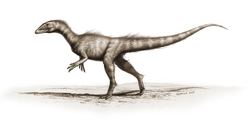 |
| Dromaeosauroides | 2003 | Jydegaard Formation (Early Cretaceous, Berriasian) |  Denmark Denmark | A referred coprolite has been found which contains fish remains, but it could instead belong to a turtle [37] | 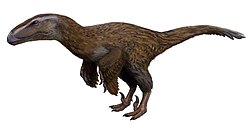 |
| Dubreuillosaurus | 2005 | Calcaire de Caen (Middle Jurassic, Bathonian) |  France France | Would have lived in a coastal mangrove swamp |  |
| Duriatitan | 2010 | Kimmeridge Clay (Late Jurassic, Kimmeridgian) |  United Kingdom United Kingdom
( England) England) | Originally named as a species of Cetiosaurus |  |
| Duriavenator | 2008 | Inferior Oolite (Middle Jurassic, Bajocian) |  United Kingdom United Kingdom
( England) England) | The basalmost known member of the Megalosaurinae, which aligns with its stratigraphic position [38] |  |
| Echinodon | 1861 | Purbeck Group (Early Cretaceous, Berriasian) |  United Kingdom United Kingdom
( England) England) | Originally misidentified as a herbivorous lizard |  |
| Efraasia | 1973 | Löwenstein Formation (Late Triassic, Norian) |  Germany Germany | Some remains assigned to this genus were originally classified in separate genera |  |
| Emausaurus | 1990 | Ciechocinek Formation (Early Jurassic, Toarcian) |  Germany Germany | One of the oldest and basalmost thyreophorans |  |
| Eotyrannus | 2001 | Wessex Formation (Early Cretaceous, Barremian) |  United Kingdom United Kingdom
( England) England) | Possessed grasping hands with three long fingers |  |
| Eousdryosaurus | 2014 | Lourinhã Formation (Late Jurassic, Kimmeridgian) |  Portugal Portugal | Described as a dryosaurid [39] but one study suggests a close relationship with elasmarians [40] | |
| Erectopus | 1923 | La Penthiève Beds (Early Cretaceous, Albian) |  France France | One of the youngest known European carnosaurs | 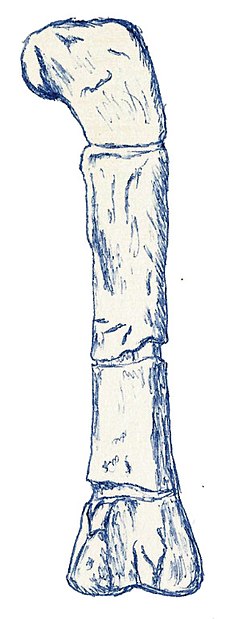 |
| Eucamerotus | 1872 | Wessex Formation (Early Cretaceous, Barremian) |  United Kingdom United Kingdom
( England) England) | Preserves extensive evidence of pneumatization | |
| Eucercosaurus | 1879 | Cambridge Greensand (Early Cretaceous, Albian) |  United Kingdom United Kingdom
( England) England) | Sometimes considered an ankylosaur but one study assigns it to Iguanodontia [41] |  |
| Euronychodon | 1991 | Argiles et sables de Taveiro (Late Cretaceous, Campanian to Maastrichtian) |  Portugal Portugal | Only known from teeth. Another species has been found in Uzbekistan |  |
| Europasaurus | 2006 | Süntel Formation (Late Jurassic, Kimmeridgian) |  Germany Germany | Much smaller than other sauropods due to its isolated island habitat [42] |  |
| Europatitan | 2017 | Castrillo de la Reina Formation (Early Cretaceous, Barremian to Aptian) |  Spain Spain | Some of this genus' remains include several vertebrae. The specific name, eastwoodi, honors director Clint Eastwood |  |
| Europelta | 2013 | Escucha Formation (Early Cretaceous, Albian) |  Spain Spain | Almost the entire skeleton is known |  |
| Eustreptospondylus | 1964 | Oxford Clay (Middle Jurassic to Late Jurassic, Callovian to Oxfordian) |  United Kingdom United Kingdom
( England) England) | May have swum between islands similar to a Komodo dragon [43] |  |
| Ferenceratops | 2026 | Densuș-Ciula Formation, Sânpetru Formation (Late Cretaceous, Maastrichtian) |  Romania Romania | Originally named as a species of Zalmoxes but it was reclassified as a ceratopsian |  |
| Fylax | 2021 | Figuerola Formation (Late Cretaceous, Maastrichtian) |  Spain Spain | Lived very late despite its comparatively basal position [44] |  |
| Galvesaurus | 2005 | Villar del Arzobispo Formation (Late Jurassic, Tithonian) |  Spain Spain | Also spelled Galveosaurus. Two sets of paleontologists named the same fossil seemingly unaware of each other's work, although there is evidence that one of them had plaigiarized the others, but misspelled the name [45] | |
| Garrigatitan | 2021 | Argiles et Grès à Reptiles Formation (Late Cretaceous, Campanian) |  France France | Known from remains of both adults and subadults | |
| Garumbatitan | 2023 | Arcillas de Morella Formation (Early Cretaceous, Barremian) |  Spain Spain | Had a reduced claw on the third toe |  |
| Genusaurus | 1995 | Bevons Beds (Early Cretaceous, Albian) |  France France | Has been suggested to be either a noasaurid [46] or an abelisaurid [47] | |
| Gideonmantellia | 2012 | Camarillas Formation (Early Cretaceous, Barremian) |  Spain Spain | Originally misidentified as a specimen of Hypsilophodon |  |
| Gigantosaurus | 1869 | Kimmeridge Clay (Late Jurassic, Kimmeridgian) |  United Kingdom United Kingdom
( England) England) | May have possessed osteoderms |  |
| Haestasaurus | 2015 | Wealden Group (Early Cretaceous, Berriasian to Valanginian) |  United Kingdom United Kingdom
( England) England) | Preserves impressions of differently-sized hexagonal scales |  |
| Halticosaurus | 1908 | Löwenstein Formation (Late Triassic, Norian) |  Germany Germany | Historically conflated with the bones of unrelated animals | |
| Heptasteornis | 1975 | Sânpetru Formation (Late Cretaceous, Maastrichtian) |  Romania Romania | Once believed to be a giant prehistoric owl |  |
| Hesperonyx | 2024 | Lourinhã Formation (Late Jurassic, Kimmeridgian) |  Portugal Portugal | Only known from the remains of the fore- and hindlimbs |  |
| Histriasaurus | 1998 | Unnamed formation (Early Cretaceous, Hauterivian to Barremian) |  Croatia Croatia | Despite being discovered in Europe, it may have lived between southern Europe and Africa in life [48] |  |
| Horshamosaurus | 2015 | Weald Clay (Early Cretaceous, Barremian) |  United Kingdom United Kingdom
( England) England) | A supposed tibia has been reinterpreted as an ischium [49] |  |
| Hungarosaurus | 2005 | Csehbánya Formation (Late Cretaceous, Santonian) |  Hungary Hungary | Possessed an elevated shoulder which may be an adaptation to high-browsing [50] |  |
| Hylaeosaurus | 1833 | Bückeberg Formation?, Grinstead Clay Formation, Tunbridge Wells Sand Formation (Early Cretaceous, Valanginian) |  Germany? Germany?
 United Kingdom United Kingdom
( England) England) | One of the three animals originally used to define the Dinosauria, along with Iguanodon and Megalosaurus |  |
| Hypselosaurus | 1869 | Argiles et Grès à Reptiles Formation (Late Cretaceous, Maastrichtian) |  France France | Several spherical eggs have been attributed to this taxon | 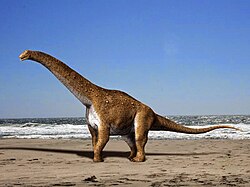 |
| Hypselospinus | 2010 | Wadhurst Clay Formation (Early Cretaceous, Valanginian) |  United Kingdom United Kingdom
( England) England) | Had elongated neural spines projecting from the top of its vertebrae |  |
| Hypsilophodon | 1869 | Wessex Formation (Early Cretaceous, Hauterivian to Barremian) |  United Kingdom United Kingdom
 England England | May have been a deer-like low browser that fed on young shoots and roots |  |
| Iberospinus | 2022 | Papo Seco Formation (Early Cretaceous, Barremian) |  Portugal Portugal | Basal yet already displays some adaptations for a semiaquatic lifestyle |  |
| Iguanodon | 1825 | Arcillas de Morella Formation, Camarillas Formation, Sainte-Barbe Clays Formation, Wadhurst Clay Formation, Weald Clay, Wealden Group, Wessex Formation (Early Cretaceous, Barremian to Aptian) |  Belgium Belgium
 Germany? Germany?
 Spain Spain
 United Kingdom United Kingdom
( England) England)
| Multiple remains are known which make it one of the best known dinosaurs | 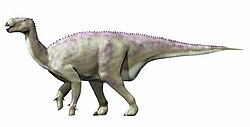 |
| Iliosuchus | 1932 | Taynton Limestone Formation (Middle Jurassic, Bathonian) |  United Kingdom United Kingdom
( England) England) | Only known from three ilia |  |
| Istiorachis | 2025 | Wessex Formation (Early Cretaceous, Barremian) |  United Kingdom United Kingdom
( England) England) | Possessed a sail-like structure formed by elongated neural spines |  |
| Iuticosaurus | 1993 | Upper Greensand Formation, Wessex Formation (Early Cretaceous to Late Cretaceous, Berriasian to Cenomanian) |  United Kingdom United Kingdom
( England) England) | Two species have been named, each from a single caudal vertebra |  |
| Juratyrant | 2013 | Kimmeridge Clay (Late Jurassic, Tithonian) |  United Kingdom United Kingdom
( England) England) | Originally named as a species of Stokesosaurus |  |
| Juravenator | 2006 | Torleite Formation (Late Jurassic, Kimmeridgian) |  Germany Germany | Impressions of both scales and feathers are known. The tail preserves structures that may be integumentary sense organs like those of crocodiles, which it may have used to prey on fish at night [51] |  |
| Lexovisaurus | 1957 | Oxford Clay (Middle Jurassic, Callovian) |  United Kingdom United Kingdom
( England) England) | Its pelvis was greatly enlarged |  |
| Liliensternus | 1984 | Trossingen Formation (Late Triassic, Norian to Rhaetian) |  Germany Germany | Although commonly depicted with a head crest, there is no evidence for such a feature |  |
| Lirainosaurus | 1999 | Marnes Rouges Inférieures Formation?, Sierra Perenchiza Formation, Sobrepena Formation (Late Cretaceous, Campanian to Maastrichtian) |  France? France?
 Spain Spain | For a titanosaur, it was small and had a relatively gracile build |  |
| Lohuecotitan | 2016 | Villalba de la Sierra Formation (Late Cretaceous, Campanian to Maastrichtian) |  Spain Spain | May have had "bulb-and-root"-type osteoderms, which are abundant at the type locality [52] |  |
| Lophostropheus | 2007 | Moon-Airel Formation (Late Triassic to Early Jurassic, Rhaetian to Hettangian) |  France France | The only substantially well-known theropod from the Triassic-Jurassic boundary [53] | |
| Loricatosaurus | 2008 | Marnes à Belemnopsis latesulcatus Formation, Oxford Clay (Middle Jurassic, Callovian) |  France France
 United Kingdom United Kingdom
( England) England) | Had narrow, flat plates on its back and round, pointed spines that ran along the tail |  |
| Losillasaurus | 2001 | Villar del Arzobispo Formation (Late Jurassic to Early Cretaceous?, Kimmeridgian to Berriasian?) |  Spain Spain | Was heterodont, having four types of teeth, one of which was heart-shaped [54] |  |
| Lourinhanosaurus | 1998 | Lourinhã Formation (Late Jurassic, Kimmeridgian to Tithonian) |  Portugal Portugal | More than one hundred eggs have been referred to this taxon |  |
| Lourinhasaurus | 1998 | Lourinhã Formation (Late Jurassic, Kimmeridgian) |  Portugal Portugal | Closely related to Camarasaurus but with proportionately longer forelimbs |  |
| Lusotitan | 2003 | Lourinhã Formation (Late Jurassic, Tithonian) |  Portugal Portugal | Originally named as a European species of Brachiosaurus |  |
| Lusovenator | 2020 | Lourinhã Formation (Late Jurassic to Early Cretaceous, Kimmeridgian to Berriasian) |  Portugal Portugal | The oldest carcharodontosaurian known from Eurasia |  |
| Macrurosaurus | 1869 | Cambridge Greensand, Chalk Group? (Early Cretaceous, Albian) |  United Kingdom United Kingdom
( England) England) | Only known from a series of caudal vertebrae |  |
| Magnamanus | 2016 | Golmayo Formation (Early Cretaceous, Hauterivian to Barremian) |  Spain Spain | Possessed relatively enlarged hands | |
| Magnosaurus | 1932 | Inferior Oolite (Middle Jurassic, Bajocian) |  United Kingdom United Kingdom
( England) England) | Confusingly, a referred specimen was simultaneously named as a species of this genus and of Sarcosaurus |  |
| Magyarosaurus | 1932 | Sânpetru Formation (Late Cretaceous, Maastrichtian) |  Romania Romania | An insular dwarf titanosaur that was one of the smallest of its group |  |
| Mantellisaurus | 2007 | Arcillas de Morella Formation, La Huérguina Formation, Lower Greensand Group, Sainte-Barbe Clays Formation, Vectis Formation, Wessex Formation (Early Cretaceous, Barremian to Aptian) |  Belgium Belgium
 Germany? Germany?
 Spain Spain
 United Kingdom United Kingdom
( England) England)
| Several specimens are known. Distinguishable from the contemporary Iguanodon by its more gracile build |  |
| Marmarospondylus | 1875 | Forest Marble Formation (Middle Jurassic, Bathonian) |  United Kingdom United Kingdom
( England) England) | Usually assigned to the genus Bothriospondylus , but this cannot be confirmed |  |
| Matheronodon | 2017 | Argiles et Grès à Reptiles Formation (Late Cretaceous, Campanian) |  France France | Had extremely specialized dentition that may have been an adaptation to feeding on tough monocot plants [55] |  |
| Megalosaurus | 1824 | Chipping Norton Limestone, Taynton Limestone Formation (Middle Jurassic, Bathonian) |  United Kingdom United Kingdom
( England) England) | The first non-avian dinosaur scientifically named and described |  |
| Metriacanthosaurus | 1964 | Oxford Clay (Late Jurassic, Oxfordian) |  United Kingdom United Kingdom
( England) England) | Possessed relatively tall neural spines for a carnosaur | 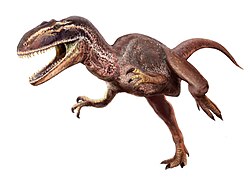 |
| Miragaia | 2009 | Lourinhã Formation (Late Jurassic, Kimmeridgian to Tithonian) |  Portugal Portugal | Had an extremely elongated neck made up of seventeen vertebrae. May be synonymous with Dacentrurus [56] [57] |  |
| Mochlodon | 1881 | Csehbánya Formation, Gosau Group (Late Cretaceous, Santonian to Campanian) |  Austria Austria
 Hungary Hungary | Originally named as a species of Iguanodon |  |
| Morelladon | 2015 | Arcillas de Morella Formation (Early Cretaceous, Barremian) |  Spain Spain | Possessed a neural spine sail lower than that of Ouranosaurus |  |
| Morinosaurus | 1874 | Unnamed formation (Late Jurassic, Kimmeridgian) |  France France | Poorly known |  |
| Neosodon | 1885 | Sables et Grès à Trigonia gibbosa (Late Jurassic, Tithonian) |  France France | No species are assigned to this genus. Popularly associated with "Iguanodon" praecursor but is in fact a separate taxon [58] | 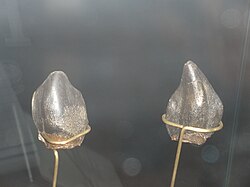 |
| Neovenator | 1996 | Wessex Formation (Early Cretaceous, Hauterivian to Barremian) |  United Kingdom United Kingdom
( England) England) | Had a complex series of neurovascular canals lining its snout [59] |  |
| Newtonsaurus | 2025 | Lilstock Formation (Late Triassic, Rhaetian) |  United Kingdom United Kingdom
( Wales) Wales) | Once considered indeterminate within Archosauria |  |
| Normanniasaurus | 2013 | Poudingue Ferrugineux (Early Cretaceous, Albian) |  France France | Represents a European radiation of basal titanosaurs [60] | |
| Notatesseraeraptor | 2019 | Klettgau Formation (Late Triassic, Norian) |  Switzerland Switzerland | Combines features of different groups of basal theropods |  |
| Nuthetes | 1854 | Lulworth Formation (Early Cretaceous, Berriasian) |  United Kingdom United Kingdom
( England) England) | Only known from jaws and teeth. Traditionally identified as a dromaeosaurid but it might be a proceratosaurid instead [61] |  |
| Obelignathus | 2025 | Argiles et Grès à Reptiles Formation (Late Cretaceous, Campanian to Maastrichtian) |  France France | Originally named as a species of Rhabdodon , but was given its own genus due to morphological and phylogenetic differences [62] |  |
| Oblitosaurus | 2023 | Villar del Arzobispo Formation (Late Jurassic, Kimmeridgian to Tithonian) |  Spain Spain | The largest ornithopod known from the Late Jurassic of Europe |  |
| Oceanotitan | 2019 | Lourinhã Formation (Late Jurassic, Kimmeridgian) |  Portugal Portugal | Potentially the oldest known somphospondylian [63] |  |
| Ohmdenosaurus | 1978 | Posidonia Shale (Early Jurassic, Toarcian) |  Germany Germany | Originally misidentified as a plesiosaur |  |
| Oplosaurus | 1852 | Wessex Formation (Early Cretaceous, Barremian) |  United Kingdom United Kingdom
( England) England) | The holotype tooth was pointed, which led to its misidentification as a carnivorous reptile [64] | 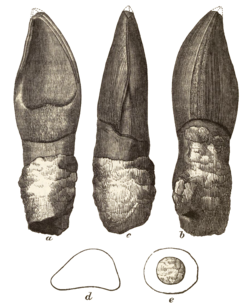 |
| Ornithodesmus | 1887 | Wessex Formation (Early Cretaceous, Barremian) |  United Kingdom United Kingdom
( England) England) | Historically conflated with the remains of the pterosaur Istiodactylus |  |
| Ornithopsis | 1870 | Wealden Group (Early Cretaceous, Barremian) |  Germany? Germany?
 United Kingdom United Kingdom
( England) England) | Originally believed to be an intermediate form between birds, pterosaurs and dinosaurs |  |
| Orthomerus | 1883 | Maastricht Formation (Late Cretaceous, Maastrichtian) |  Netherlands Netherlands | Potentially dubious and undiagnostic [65] |  |
| Ostromia | 2017 | Painten Formation (Late Jurassic, Tithonian) |  Germany Germany | Considered a small pterosaur until it was redescribed as a specimen of Archaeopteryx in 1970. [66] Some of its features are similar to those of Anchiornis | 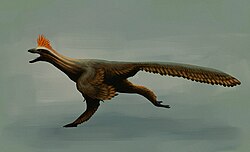 |
| Owenodon | 2009 | Lulworth Formation (Early Cretaceous, Berriasian) |  United Kingdom United Kingdom
( England) England) | Has been assigned to Iguanodon and Camptosaurus before it received its own genus | 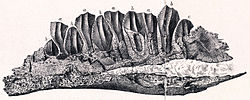 |
| Paludititan | 2010 | Sânpetru Formation (Late Cretaceous, Maastrichtian) |  Romania Romania | Some of its bones are identical to those of Magyarosaurus , but their synonymy cannot be confirmed |  |
| Pararhabdodon | 1993 | Tremp Formation (Late Cretaceous, Maastrichtian) |  Spain Spain | The first lambeosaurine identified from Europe |  |
| Pareisactus | 2019 | Tremp Formation (Late Cretaceous, Maastrichtian) |  Spain Spain | Represented by a single scapula recovered from a hadrosaur bonebed |  |
| Paulodon | 2025 | Camarillas Formation (Early Cretaceous, Barremian) |  Spain Spain | Previously assigned to the contemporary Iguanodon |  |
| Pelecanimimus | 1994 | La Huérguina Formation (Early Cretaceous, Barremian) |  Spain Spain | Preserves extensive soft tissue impressions revealing the presence of a keratinous head crest and a pelican-like gular pouch |  |
| Pelorosaurus | 1850 | Tunbridge Wells Sand Formation (Early Cretaceous, Hauterivian) |  United Kingdom United Kingdom
( England) England) | The first sauropod identified as a terrestrial animal |  |
| Pendraig | 2021 | Pant-y-Ffynnon Quarry (Late Triassic, Rhaetian) |  United Kingdom United Kingdom
( Wales) Wales) | Would have lived on a dry limestone island [67] |  |
| Petrustitan | 2025 | Sânpetru Formation (Late Cretaceous, Maastrichtian) |  Romania Romania | Formerly identified as a species of Magyarosaurus , but it is markedly different from that genus |  |
| Phyllodon | 1973 | Alcobaça Formation (Late Jurassic, Kimmeridgian) |  Portugal Portugal | The front and back of its teeth were asymmetrical |  |
| Piveteausaurus | 1977 | Marnes de Dives (Middle Jurassic, Callovian) |  France France | Has been suggested to be a species of Proceratosaurus |  |
| Plateosaurus | 1837 | Klettgau Formation, Löwenstein Formation, Lunde Formation, Trossingen Formation (Late Triassic, Norian) |  France? France?
 Germany Germany
 Norway Norway
 Switzerland Switzerland | Known from over a hundred skeletons, several of them nearly complete |  |
| Pneumatoraptor | 2010 | Csehbánya Formation (Late Cretaceous, Santonian) |  Hungary Hungary | One study suggests a position as a possible early palaeognath [68] |  |
| Poekilopleuron | 1836 | Calcaire de Caen (Middle Jurassic, Bathonian) |  France France | Its holotype was found alongside fish remains [69] |  |
| Polacanthus | 1865 | Wessex Formation (Early Cretaceous, Barremian) |  United Kingdom United Kingdom
( England) England) | Possessed a flat sacral shield dotted with small bumps | 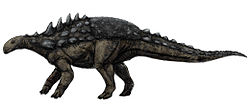 |
| Portellsaurus | 2021 | Margas de Mirambell Formation (Early Cretaceous, Barremian) |  Spain Spain | Closely related to Ouranosaurus [70] |  |
| Priodontognathus | 1875 | Lower Calcareous Grit (Late Jurassic, Oxfordian) |  United Kingdom United Kingdom
( England) England) | Only known from a single maxilla with teeth | |
| Proa | 2012 | Escucha Formation (Early Cretaceous, Albian) |  Spain Spain | The tip of its jaw was shaped like the bow of a ship |  |
| Proceratosaurus | 1926 | Great Oolite Group (Middle Jurassic, Bathonian) |  United Kingdom United Kingdom
( England) England) | Preserves a small horn on its snout which may have anchored a crest as in the related Guanlong | 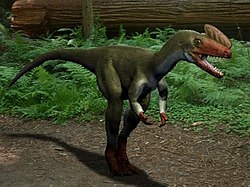 |
| Procompsognathus | 1913 | Löwenstein Formation (Late Triassic, Norian) |  Germany Germany | Has been suggested to be non-dinosaurian |  |
| Protathlitis | 2023 | Arcillas de Morella Formation (Early Cretaceous, Barremian) |  Spain Spain | Described as a basal baryonychine spinosaurid, but a recent study suggested the type material may be chimeric, regarding this genus as probably dubious [20] |  |
| Pterospondylus | 1913 | Trossingen Formation (Late Triassic, Norian) |  Germany Germany | Known from only a single, large vertebra |  |
| Pyroraptor | 2000 | Argiles et Grès à Reptiles Formation (Late Cretaceous, Campanian to Maastrichtian) |  France France | Its holotype specimen was exposed by a forest fire |  |
| Qunkasaura | 2024 | Villalba de la Sierra Formation (Late Cretaceous, Campanian to Maastrichtian) |  Spain Spain | May have been closely related to Abditosaurus [71] |  |
| Regnosaurus | 1848 | Tunbridge Wells Sand Formation (Early Cretaceous, Berriasian to Valanginian) |  United Kingdom United Kingdom
( England) England) | Potentially a stegosaur similar to Huayangosaurus [72] | 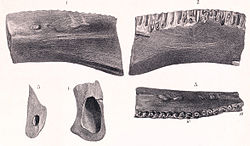 |
| Rhabdodon | 1869 | Grès de Labarre, Gres de Saint-Chinian, Marnes Rouges Inférieures Formation, Villalba de la Sierra Formation (Late Cretaceous, Maastrichtian) |  France France
 Spain Spain | Although most rhabdodontids are insular dwarfs, this genus may represent an instance of island gigantism as it is much larger than other members of its family [73] |  |
| Riabininohadros | 2020 | Unnamed formation (Late Cretaceous, Maastrichtian) |  Ukraine Ukraine | Possessed a femur so unique it has no morphological equivalents across all of Iguanodontia | |
| Riojavenatrix | 2024 | Enciso Group (Early Cretaceous, Barremian to Aptian) |  Spain Spain | Originally identified as a specimen of Baryonyx |  |
| Riparovenator | 2021 | Wessex Formation (Early Cretaceous, Barremian) |  United Kingdom United Kingdom
( England) England) | Had elongated spines projecting from its caudal vertebrae somewhat similar to those of Spinosaurus |  |
| Ruehleia | 2001 | Trossingen Formation (Late Triassic, Norian) |  Germany Germany | Known from a single, nearly complete skeleton |  |
| Saltriovenator | 2018 | Saltrio Formation (Early Jurassic, Sinemurian) |  Italy Italy | The biggest theropod from the Early Jurassic yet known |  |
| Sarcolestes | 1893 | Oxford Clay (Middle Jurassic, Callovian) |  United Kingdom United Kingdom
( England) England) | Originally misidentified as a carnivorous dinosaur |  |
| Sarcosaurus | 1921 | Scunthorpe Mudstone (Early Jurassic, Hettangian to Sinemurian) |  United Kingdom United Kingdom
( England) England) | Has been variously suggested to be in different positions at the base of Neotheropoda [74] [75] [76] [77] |  |
| Scelidosaurus | 1859 | Charmouth Mudstone Formation (Early Jurassic, Sinemurian to Pliensbachian) |  United Kingdom United Kingdom
( England) England) | Carried hundreds of small osteoderms in several rows along its back |  |
| Schleitheimia | 2020 | Klettgau Formation (Late Triassic, Norian) |  Switzerland Switzerland | Possessed a relatively enlarged ilium | |
| Scipionyx | 1998 | Pietraroja Plattenkalk (Early Cretaceous, Albian) |  Italy Italy | So well preserved that several internal organs and their positions in life could be accurately reconstructed |  |
| Sciurumimus | 2012 | Torleite Formation (Late Jurassic, Kimmeridgian) |  Germany Germany | Had a bushy tail similar to that of a squirrel | 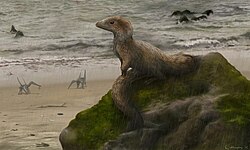 |
| Soriatitan | 2017 | Golmayo Formation (Early Cretaceous, Hauterivian to Barremian) |  Spain Spain | The first confirmed brachiosaurid known from Early Cretaceous Europe | 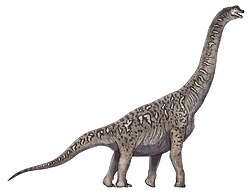 |
| Stenopelix | 1857 | Obernkirchen Sandstein (Early Cretaceous, Berriasian) |  Germany Germany | Possibly closely related to basal ceratopsians from Late Jurassic China [78] | 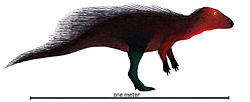 |
| Streptospondylus | 1832 | Marnes de Dives?/Marnes de Villers? (Middle Jurassic to Late Jurassic, Callovian to Oxfordian) |  France France | Originally believed to represent a marine crocodile |  |
| Struthiosaurus | 1871 | Argiles et Grès à Reptiles Formation, Gosau Group, Sânpetru Formation (Late Cretaceous, Santonian to Maastrichtian) |  Austria Austria
 France France
 Hungary? Hungary?
 Romania Romania | Analysis of its braincase suggests poor hearing and a sluggish, solitary lifestyle [79] |  |
| Syngonosaurus | 1879 | Cambridge Greensand (Early Cretaceous, Albian) |  United Kingdom United Kingdom
( England) England) | Usually considered a synonym of Acanthopholis but it has been reinterpreted as an iguanodont [41] |  |
| Tamarro | 2021 | Tremp Formation (Late Cretaceous, Maastrichtian) |  Spain Spain | May have been closely related to Asian troodontids [80] |  |
| Tanystrosuchus | 1963 | Löwenstein Formation (Late Triassic, Norian) |  Germany Germany | The only known vertebra was once misidentified as a phytosaur | |
| Tarascosaurus | 1991 | Fuvelian Beds (Late Cretaceous, Campanian) |  France France | If an abelisaurid it would be one of the few northern members of the group |  |
| Tastavinsaurus | 2008 | Forcall Formation, Xert Formation (Early Cretaceous, Barremian) |  Spain Spain | Could represent an obscure group of macronarians called Laurasiformes [81] |  |
| Teinurosaurus | 1928 | Mont-Lambert Formation (Late Jurassic, Tithonian) |  France France | Poorly known |  |
| Telmatosaurus | 1903 | Sânpetru Formation (Late Cretaceous, Maastrichtian) |  Romania Romania | One specimen preserves a facial deformity caused by an ameloblastoma [82] |  |
| Tethyshadros | 2009 | Calcare di Aurisina (Late Cretaceous, Campanian) |  Italy Italy | Had limbs adapted for high speed but were too short for running [50] |  |
| Thecocoelurus | 1923 | Wessex Formation (Early Cretaceous, Barremian) |  United Kingdom United Kingdom
( England) England) | Has been assigned to a variety of theropod groups throughout history |  |
| Thecodontosaurus | 1836 | Magnesian Conglomerate (Late Triassic, Rhaetian) |  United Kingdom United Kingdom
( England) England) | Could have been an extremely fast bipedal runner [83] |  |
| Thecospondylus | 1882 | Wealden Group (Early Cretaceous, Valanginian to Hauterivian) |  United Kingdom United Kingdom
( England) England) | Indeterminate within Dinosauria |  |
| Torvosaurus | 1979 | Kimmeridge Clay?, Lourinhã Formation, Ornatenton Formation, Vega Formation? (Middle Jurassic to Late Jurassic, Callovian to Tithonian) |  Germany Germany
 Portugal Portugal
 Spain? Spain?
 United Kingdom United Kingdom
( England?) England?) | The type species was found in the United States. Several species lived around the world, including in Europe, but T. gurneyi is the only non-North American species to receive a formal name. It represents Europe's largest terrestrial predator [84] |  |
| Transylvanosaurus | 2022 | Pui Beds (Late Cretaceous, Maastrichtian) |  Romania Romania | Had an unusually wide skull compared to other rhabdodontids |  |
| Trimucrodon | 1973 | Lourinhã Formation (Late Jurassic, Kimmeridgian) |  Portugal Portugal | Possessed wedge-shaped teeth | |
| Tuebingosaurus | 2022 | Trossingen Formation (Late Triassic, Norian) |  Germany Germany | Although originally assigned to Plateosaurus , it contains several features that point to a more derived position |  |
| Turiasaurus | 2006 | Villar del Arzobispo Formation (Late Jurassic, Kimmeridgian to Tithonian) |  Spain Spain | Extremely large despite not being a member of Neosauropoda |  |
| Uriash | 2025 | Densuș-Ciula Formation (Late Cretaceous, Maastrichtian) |  Romania Romania | One of the largest European sauropods |  |
| Valdosaurus | 1977 | Weald Clay, Wealden Group, Wessex Formation (Early Cretaceous, Berriasian to Barremian) |  United Kingdom United Kingdom
( England) England) | Large and similar to Dryosaurus | 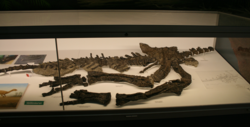 |
| Vallibonavenatrix | 2019 | Arcillas de Morella Formation (Early Cretaceous, Barremian) |  Spain Spain | One of the most complete spinosaurids known from Iberia |  |
| Variraptor | 1998 | Argiles et Grès à Reptiles Formation (Late Cretaceous, Campanian to Maastrichtian) |  France France | May be closely related to Bambiraptor [68] |  |
| Vectaerovenator | 2020 | Lower Greensand Group (Early Cretaceous, Aptian) |  United Kingdom United Kingdom
( England) England) | Only known from four vertebrae but are distinct enough to be classified as their own genus |  |
| Vectidromeus | 2024 | Wessex Formation (Early Cretaceous, Barremian) |  United Kingdom United Kingdom
( England) England) | Originally described as a relative of the coeval Hypsilophodon , but a subsequent analysis suggests possible dryosaurid affinities for this genus [85] |  |
| Vectipelta | 2023 | Wessex Formation (Early Cretaceous, Hauterivian to Barremian) |  United Kingdom United Kingdom
( England) England) | May have been more closely related to Asian ankylosaurs than to European ones [86] |  |
| Vectiraptor | 2021 | Wessex Formation (Early Cretaceous, Barremian) |  United Kingdom United Kingdom
( England) England) | Shares some features with North American dromaeosaurids |  |
| Velocipes | 1932 | Lissauer Breccia (Late Triassic, Norian) |  Poland Poland | Has been considered a dubious, indeterminate vertebrate [87] |  |
| Volgatitan | 2018 | Unnamed formation (Early Cretaceous, Hauterivian) |  Russia Russia | Closely related to South American titanosaurs |  |
| Vouivria | 2017 | Calcaires de Clerval (Late Jurassic, Oxfordian) |  France France | The oldest known titanosauriform |  |
| Wiehenvenator | 2016 | Ornatenton Formation (Middle Jurassic, Callovian) |  Germany Germany | Before its formal description, it had been nicknamed the "Minden Monster" |  |
| Xenoposeidon | 2007 | Wealden Group (Early Cretaceous, Berriasian to Valanginian) |  United Kingdom United Kingdom
( England) England) | Only known from a single, very unique vertebra |  |
| Yaverlandia | 1971 | Vectis Formation?, Wessex Formation (Early Cretaceous, Barremian) |  United Kingdom United Kingdom
( England) England) | Originally misidentified as a pachycephalosaur because of its thick skull roof |  |
| Zalmoxes | 2003 | Densuș-Ciula Formation, Sânpetru Formation, Sebeș Formation (Late Cretaceous, Maastrichtian) |  Romania Romania | Has been suggested to be a European ceratopsian [88] |  |
| Zby | 2014 | Lourinhã Formation (Late Jurassic, Kimmeridgian) |  Portugal Portugal | Originally believed to be a specimen of Turiasaurus |  |
|



















































































































































































































